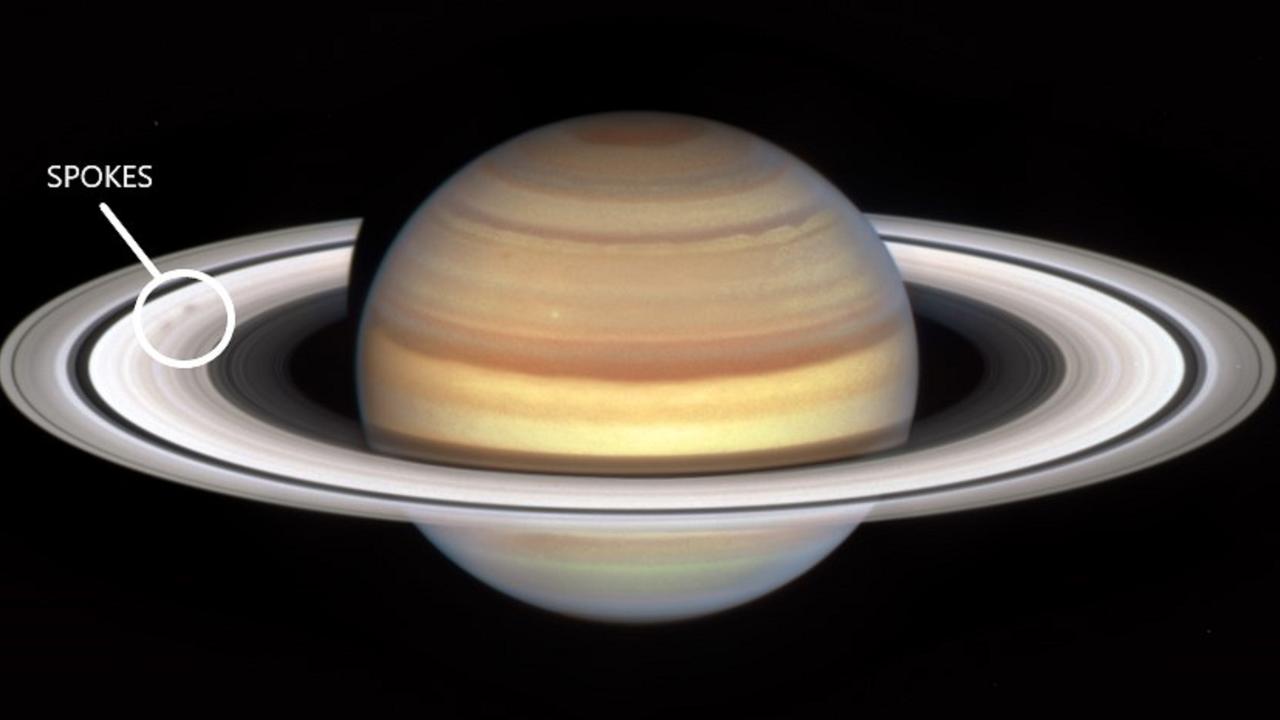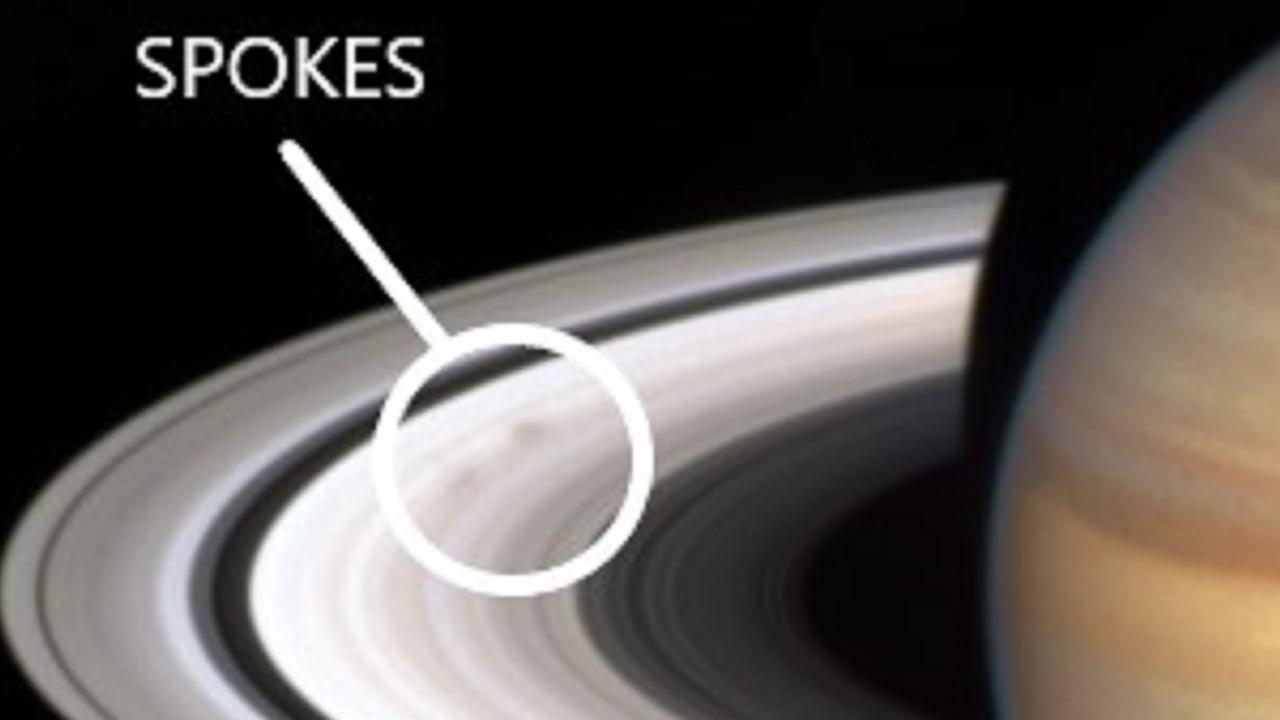NASA can’t explain new smudges found on Saturn’s rings
New Hubble Space Telescope images have revealed strange marks on Saturn’s rings - and scientists are baffled

READING LEVEL: ORANGE
New Hubble Space Telescope* images have revealed* strange marks on Saturn’s rings - and scientists are baffled*.
The light and dark smudges*, also known as spokes, mark the start of the planet’s “spoke season”.
NASA scientists first spotted them over four decades* ago during the Voyager Mission* in the 1980s, but remain bewildered* over the cause.
The smudges have previously been spotted in the years before and after Saturn’s equinox*, and Hubble* last captured them around 15 years ago, during the Cassini mission*.

The planet’s next autumnal equinox* is set to begin on May 6, 2025, and the marks can start to appear four years prior*.
Hubble will continue to monitor* the spokes, and stargazers* can expect to see more as the autumnal equinox* approaches.
What’s behind the spokes?
NASA scientists intend to use the images to reach a better understanding* of what causes the ghostly spots, and why they are seasonal*.
“Thanks to Hubble’s OPAL program, which is building an archive of data on the outer solar system planets, we will have longer dedicated time to study Saturn’s spokes this season than ever before,” NASA senior planetary scientist Amy Simon said in a statement.

“The precise beginning and duration of the spoke season is still unpredictable*, rather like predicting the first storm during hurricane season,” Simon added.
While the reason for the seasonal marks remains unknown, experts have a few theories.
“The suspected culprit* for the spokes is the planet’s variable magnetic field*,” NASA said in a press release.
Scientists think that smaller, icy particles can become charged, which temporarily* floats them above the rest of the larger particles and boulders in the rings.
Something similar happens on Earth, but we see it as the northern lights.
“It’s a fascinating magic trick of nature we only see on Saturn — for now at least,” Simon said.
By adding the latest images to an archive of data from the Voyager* and Cassini missions*, NASA hopes to crack the mystery* of the spokes once and for all.

The images are the latest in a string of recent galactic* discoveries.
Last month, NASA spotted a second Earth-size, habitable* planet orbiting* a small star 100 light-years* away, it announced at an American Astronomical Society meeting.
Then just weeks later, an asteroid the size of a box truck made one of the closest passes of planet Earth ever recorded, NASA announced in a statement. It’s possible that other planets with rings could experience similar events, but for now, they’ve only been observed on Saturn’s rings.
This story was originally published by The Sun and is reproduced here with permission.
GLOSSARY
- Hubble Space Telescope: a large telescope in space designed to explore the universe in visible, ultraviolet and infrared wavelengths. It was launched into orbit by space shuttle Discovery on April 24, 1990
- revealed: to make known or show something that is surprising or that was previously secret
- baffled: extremely confused or puzzled
- smudges: a blurred or smeared mark on the surface of something
- decades: a period of ten years
- Voyager Mission: The Voyager program consists of two spacecraft: Voyager 1 and Voyager 2. Voyager 2 was launched first, in August 1977, Voyager 1 was sent on a faster trajectory when it launched about two weeks later. They are the only two functioning spacecraft currently in interstellar space, beyond the environment controlled by the sun
- bewildered: very confusing and difficult to understand or to make a decision about
- Saturn’s equinox: During Saturn’s equinoxes, the rings (and Saturn’s equator) line up perfectly with the sun
- Cassini missions: a robotic spacecraft sent to study Saturn and its complex system of rings and moons
- prior: existing or coming before in time
- monitor: a device used for observing, checking, or keeping a continuous record of something
- autumnal: occurring in autumn
- understanding: knowledge of a particular thing
- seasonal: happening during a particular time of the year
- unpredictable: involving changes you cannot prepare for
- culprit: the cause of a problem or defect
- magnetic field: an area around a magnet, or something functioning as a magnet, in which the magnet’s power to attract things is felt
- temporarily: in a way that does not last for long
- mystery: something that is difficult or impossible to understand or explain
- galactic: relating to a galaxy or galaxies
- habitable: suitable or good enough to live in
- orbiting: to follow a curved path around a planet or star
- light-years: the distance light travels in one year
EXTRA READING
Rover records sound of Martian ‘dust devil’
Jupiter’s record-breaking 92 moons
Phew! Truck-sized asteroid misses Earth
QUICK QUIZ
- How long ago did NASA scientists first spot smudges, or spokes, on Saturn’s rings?
- During what event have the smudges previously been visible?
- What is the name of the telescope used to take the images of Saturn?
- Describe one theory for the seasonal marks?
- What are the names of two different space missions mentioned in this story?
LISTEN TO THIS STORY
CLASSROOM ACTIVITIES
1. Spoke season
Look at the images of the smudges on Saturn’s rings from the Hubble telescope, and describe what you see.
Think of your own scientific and/or imaginative explanation as to what these smudges, and what ‘spoke season’ could be on Saturn?
Time: allow 20 minutes to complete this activity
Curriculum Links: English, Science, Critical and creative thinking
2. Extension
If an asteroid the size of a truck, is trajecting dangerously towards Earth, how do you think the powers that be would protect us? What could they do to redirect an asteroid in a different direction?
Time: allow 10 minutes to complete this activity
Curriculum Links: English, Science, Critical and creative thinking
VCOP ACTIVITY
Wow word recycle
There are plenty of wow words (ambitious pieces of vocabulary) being used in the article. Some are in the glossary, but there might be extra ones from the article that you think are exceptional as well.
Identify all the words in the article that you think are not common words, and particularly good choices for the writer to have chosen.
Select three words you have highlighted to recycle into your own sentences.
If any of the words you identified are not in the glossary, write up your own glossary for them.

